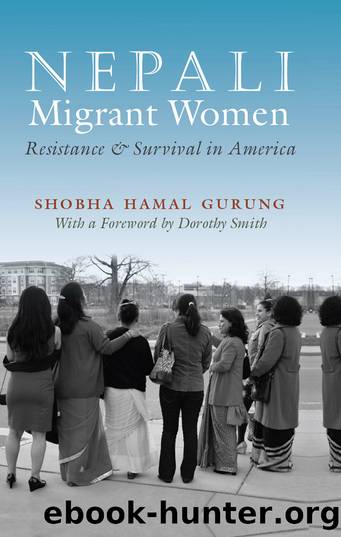Nepali Migrant Women by Hamal Gurung Shobha;Smith Dorothy;

Author:Hamal Gurung, Shobha;Smith, Dorothy;
Language: eng
Format: epub
Publisher: Syracuse University Press
Nearly every mother in this study indicated that transnational family arrangements harmed her ability to mother and that she longed to be with her children. Like other transnational mothers, Nepali women provided love, care, and support to their children through phone calls, e-mails, gifts, and remittances. When they finished a long day or night of paid care work, women began their second shift providing long-distance mothering to their biological children. Women indicated that they often called home to Nepal between 9 p.m. and 6 a.m. when cell phone minutes were free. Through phone calls, e-mail, Instant Messaging, Skype, and other forms of social media, women expressed affection for their children, offered advice, and participated in decision-making regarding their care.
In addition to regular communication over the phone, Internet, or through social media, women also sent remittance money back to Nepal to support their children economically and showered their children with expensive gifts. Long-distance communication and financial support could not fully substitute for their physical presence in their childrenâs lives, however. Physical separation took a significant toll on the emotional and psychological well-being of mothers and children alike, especially among younger children. In her study of undocumented Salvadoran working mothers in the United States, Horton (2009) reports that mothers experienced a feeling of moral failure, powerlessness, and emotional trauma when they could not reunite with their children within their expected time frame. Children also resented their mothers or pleaded that they return home. Likewise, the mothers and children in this study experienced some emotional and psychological harm as a result of their separation. For example, Tara lamented: âI havenât seen my children for five years. They were very young when I left. They were ten, eleven years old. Now when I see their photographs, I canât even recognize them. Theyâve changed so much. Theyâve grown so much. I call [my children] almost every day, sometimes twice a day. . . . If I donât hear their voices, then I will go crazy. I called them this morning to wake them up because they have their exams going on right now. . . . I am physically here, but I am mentally with my kids all the time.â
According to Tara, her children were equally concerned about her well-being: âI was very sick on Motherâs Day and I had to be hospitalized. My son told me that he had nightmares about me getting hurt so he told me to come back. He said that if we are together, then we can get through all the hurdles in life together. I really want to see them.â
Although physical separation caused pain and suffering, mothers recognized the importance of a good education and a better life for their children. Single mothers in particular were working hard in the United States so their children could attend elite private schools in Nepal or abroad.2 All the mothers hoped to bring their children to the United States one day, particularly to provide a US education that would provide greater job prospects, economic security, and personal security.
Download
This site does not store any files on its server. We only index and link to content provided by other sites. Please contact the content providers to delete copyright contents if any and email us, we'll remove relevant links or contents immediately.
| General | Men |
| Women in History |
Cecilia; Or, Memoirs of an Heiress — Volume 1 by Fanny Burney(32075)
Cecilia; Or, Memoirs of an Heiress — Volume 3 by Fanny Burney(31469)
Cecilia; Or, Memoirs of an Heiress — Volume 2 by Fanny Burney(31419)
The Great Music City by Andrea Baker(30797)
We're Going to Need More Wine by Gabrielle Union(18641)
All the Missing Girls by Megan Miranda(14788)
Pimp by Iceberg Slim(13798)
Bombshells: Glamour Girls of a Lifetime by Sullivan Steve(13698)
Fifty Shades Freed by E L James(12925)
Talking to Strangers by Malcolm Gladwell(12888)
Norse Mythology by Gaiman Neil(12861)
For the Love of Europe by Rick Steves(11558)
Crazy Rich Asians by Kevin Kwan(8898)
Mindhunter: Inside the FBI's Elite Serial Crime Unit by John E. Douglas & Mark Olshaker(8721)
The Lost Art of Listening by Michael P. Nichols(7170)
Enlightenment Now: The Case for Reason, Science, Humanism, and Progress by Steven Pinker(6879)
The Four Agreements by Don Miguel Ruiz(6326)
Bad Blood by John Carreyrou(6284)
Weapons of Math Destruction by Cathy O'Neil(5846)
